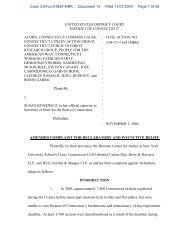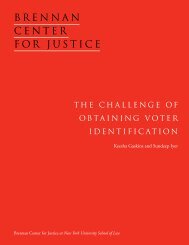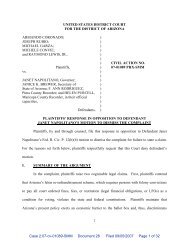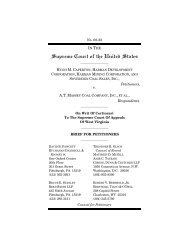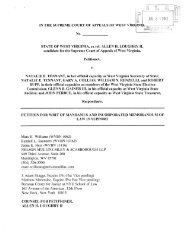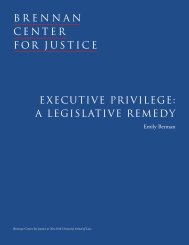THE NEW YORK STATE LEGISLATIVE PROCESS: AN ...
THE NEW YORK STATE LEGISLATIVE PROCESS: AN ...
THE NEW YORK STATE LEGISLATIVE PROCESS: AN ...
You also want an ePaper? Increase the reach of your titles
YUMPU automatically turns print PDFs into web optimized ePapers that Google loves.
<strong>NEW</strong> <strong>YORK</strong> <strong>STATE</strong>’S <strong>LEGISLATIVE</strong> <strong>PROCESS</strong><br />
■ <strong>THE</strong> SHORT <strong>LEGISLATIVE</strong> <strong>PROCESS</strong><br />
The period of time in a session between the introduction of a bill and its final<br />
passage by both chambers of the Legislature is the timeframe during which any<br />
review, debate, deliberation, or amendment of that bill occurs. In New York, that<br />
period is generally extremely brief, even for the major legislation that one might<br />
expect to receive the most sustained attention from legislators.<br />
For the 308 major laws passed from 1997 through 2001, the median number of<br />
days between a bill’s introduction and its passage was 10 in the Assembly and 35<br />
in the Senate. 23 In the Assembly, 124 out of the 308 laws (i.e., 40.3%) were passed<br />
within five days or fewer of their introduction. In the Senate, 85 laws (i.e., 27.6%)<br />
were passed within five days or fewer. Notably, in both 1997 and 2000, the<br />
Assembly spent a median of just two days on major legislation between introduction<br />
and final passage. See Fig. 1.<br />
With such an abbreviated period available between a bill’s introduction and its<br />
passage, there is rarely even the possibility that legislators could meaningfully<br />
review, consider, hold hearings on, debate, or amend a bill prior to its passage.<br />
To be sure, individual legislators may have considered the issue at hand before<br />
the legislation itself is introduced. In addition, some of these bills were doubtless<br />
versions of earlier bills that may have been passed or considered in prior<br />
sessions by one of the two chambers. Still, even in such cases, consideration<br />
of an earlier version of a bill or of the general issue it addresses cannot fully<br />
substitute for the careful consideration that a bill should itself receive prior to<br />
final passage.<br />
The subsections that follow document a legislative process that facilitates speedy<br />
passage of legislation without full consideration, debate, or amendments by<br />
legislators. Specifically, the section addresses each of five steps in the life of a<br />
bill – committee consideration, procession through the legislative calendar, debate<br />
and amendments on the floor, passage by each chamber, and reconciliation<br />
between chambers – to compare New York’s legislative process with that of other<br />
state legislatures and Congress. 24 In addition, we analyze committee staffing<br />
and assignments, which have a significant impact on that process.<br />
■ CONSIDERATION BY COMMITTEES<br />
In most modern legislatures, committees “are the locus of most legislative<br />
activity.” 25 Committees have two principal functions: first, to enable legislators to<br />
develop, examine, solicit public and expert feedback upon, and improve bills in a<br />
specific area of expertise and to convey the results of their work to the full<br />
chamber; 26 and second, to oversee certain administrative agencies to ensure that<br />
they fulfill their statutory mandates. New York’s high volume of bills introduced<br />
FIGURE 1<br />
<strong>NEW</strong> <strong>YORK</strong> <strong>STATE</strong> LEGISLATURE<br />
■<br />
DAYS BETWEEN INTRODUCTION<br />
<strong>AN</strong>D PASSAGE OF<br />
MAJOR LEGISLATION 1997-2001<br />
SENATE<br />
Days Number of Bills<br />
0 20 40 60 80 100 120<br />
1– 9<br />
10 – 19<br />
20 – 29<br />
30 – 39<br />
40 – 49<br />
50 – 59<br />
60 – 69<br />
70 – 79<br />
80 – 89<br />
90 – 99<br />
100 – 109<br />
110 – 119<br />
120 – 129<br />
130 – 139<br />
140 – 149<br />
150 – 159<br />
160 – 169<br />
170 – 179<br />
180 – 189<br />
190 – 199<br />
200 – 209<br />
ASSEMBLY<br />
Days Number of Bills<br />
0 20 40 60 80 100 120 140 160<br />
1– 9<br />
10 – 19<br />
20 – 29<br />
30 – 39<br />
40 – 49<br />
50 – 59<br />
60 – 69<br />
70 – 79<br />
80 – 89<br />
90 – 99<br />
100 – 109<br />
110 – 119<br />
120 – 129<br />
130 – 139<br />
140 – 149<br />
150 – 159<br />
160 – 169<br />
5



